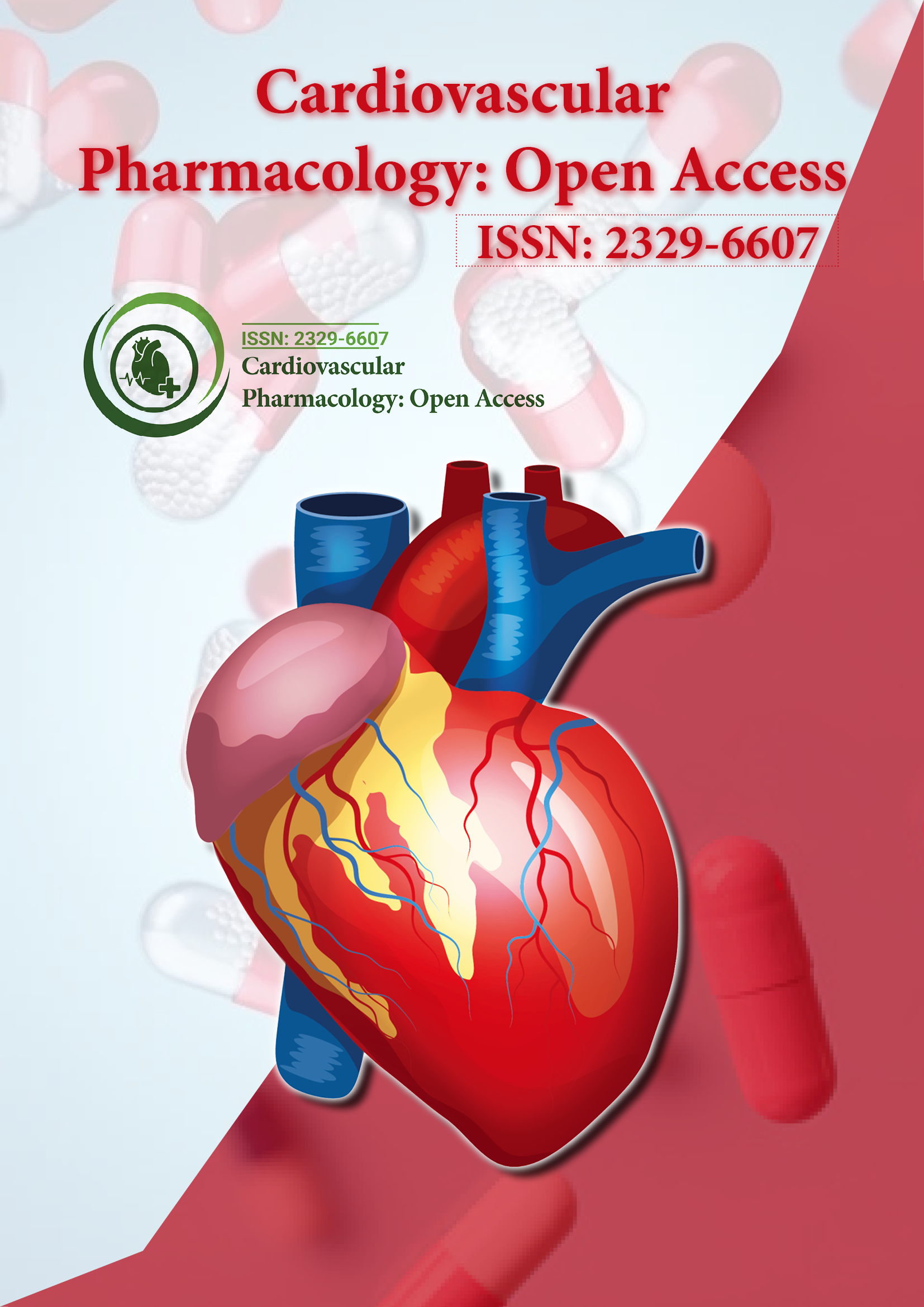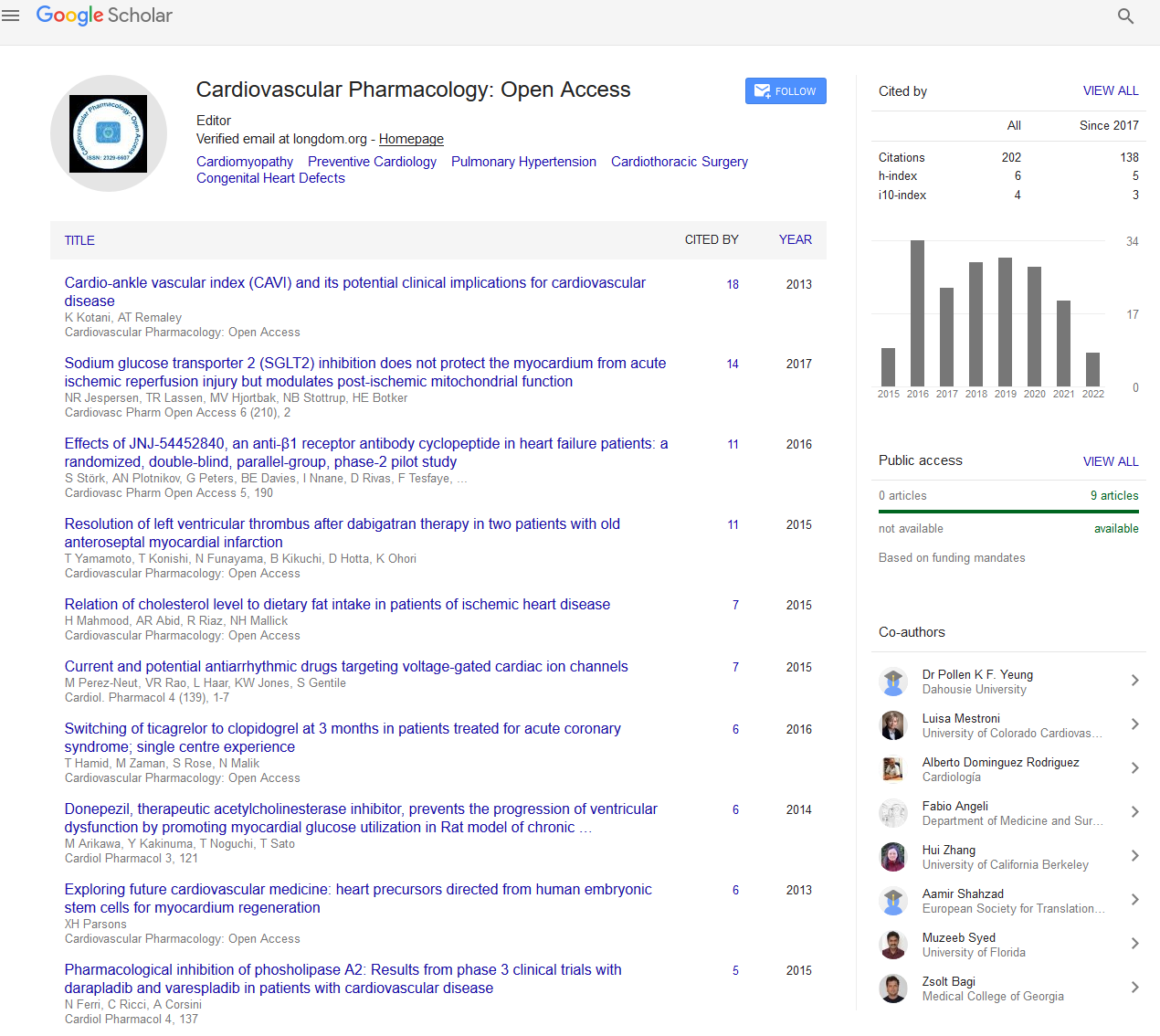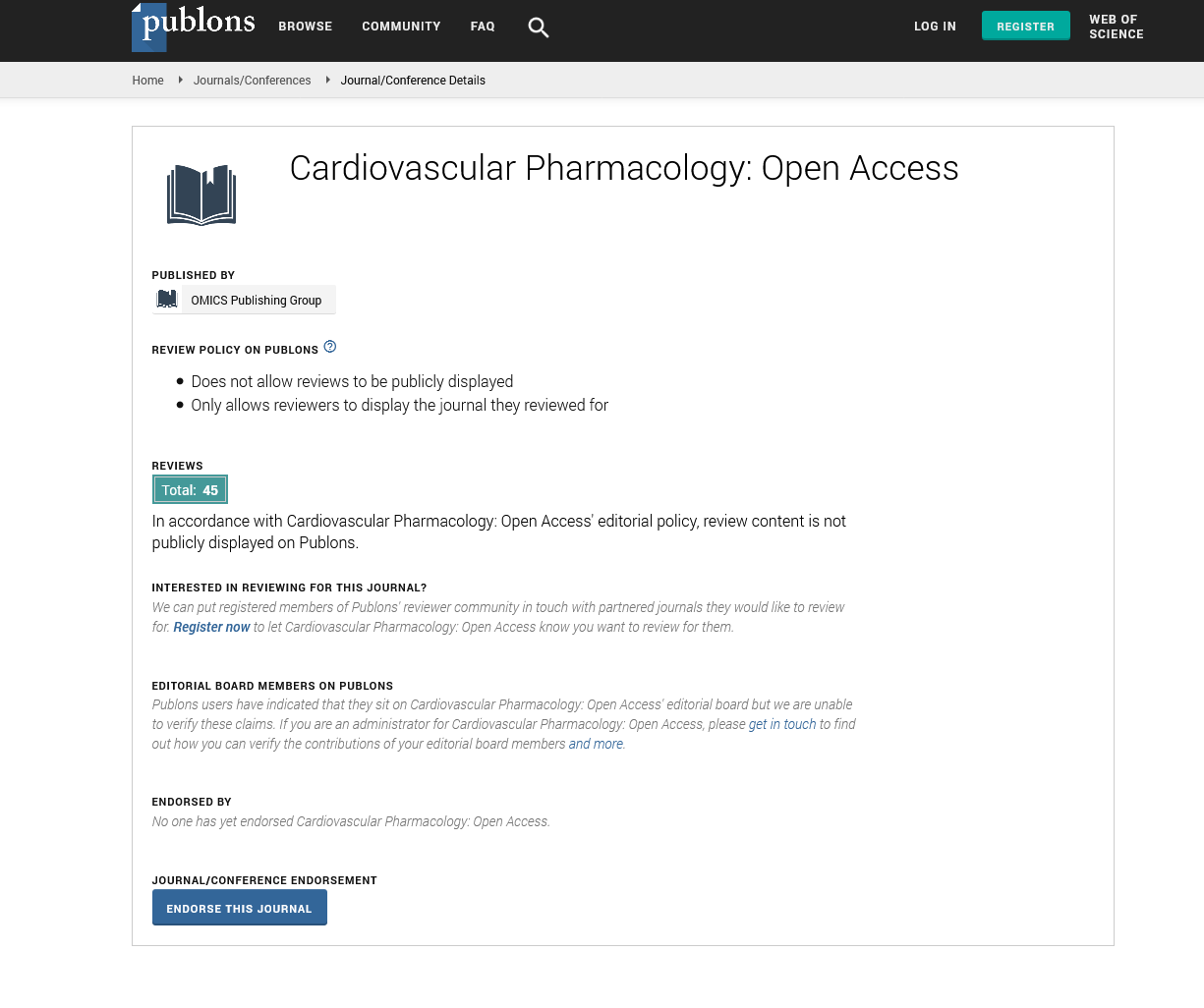Indexed In
- Open J Gate
- Cosmos IF
- RefSeek
- Hamdard University
- EBSCO A-Z
- OCLC- WorldCat
- Publons
- Geneva Foundation for Medical Education and Research
- Euro Pub
- Google Scholar
Useful Links
Share This Page
Journal Flyer

Open Access Journals
- Agri and Aquaculture
- Biochemistry
- Bioinformatics & Systems Biology
- Business & Management
- Chemistry
- Clinical Sciences
- Engineering
- Food & Nutrition
- General Science
- Genetics & Molecular Biology
- Immunology & Microbiology
- Medical Sciences
- Neuroscience & Psychology
- Nursing & Health Care
- Pharmaceutical Sciences
Opinion - (2024) Volume 13, Issue 2
Cardiovascular Effects of Diabetes Medications: Implications for Drug Repurposing
Minzi Shen*Received: 24-May-2024, Manuscript No. CPO-24-27315; Editor assigned: 27-May-2024, Pre QC No. CPO-24-27315 (PQ); Reviewed: 10-Jun-2024, QC No. CPO-24-27315; Revised: 18-Jun-2024, Manuscript No. CPO-24-27315 (R); Published: 26-Jun-2024, DOI: 10.35248/2329-6607.24.13.395
Description
Diabetes mellitus, particularly type 2 diabetes, is a major risk factor for Cardiovascular Disease (CVD), contributing significantly to morbidity and mortality worldwide. The close link between diabetes and cardiovascular complications has intensified research into diabetes medications that may benefit cardiovascular health beyond glucose control. Emerging evidence has shown that certain classes of diabetes drugs have significant cardiovascular effects, which has fueled interest in repurposing these medications for broader cardiovascular applications. This article discusses the cardiovascular effects of diabetes medications, the mechanisms underlying these effects and the potential for drug repurposing to improve cardiovascular outcomes.
Cardiovascular disease in diabetes: A dual challenge
Cardiovascular complications are the leading cause of death in patients with diabetes. High blood glucose levels contribute to endothelial dysfunction, inflammation and oxidative stress, which promote atherosclerosis, hypertension and heart failure. Effective diabetes management is necessary for reducing blood glucose levels and minimizing long-term cardiovascular risk. However, traditional diabetes medications have generally focused on glycemic control without addressing cardiovascular risk factors directly, leading to the development of newer drugs with both glucose-lowering and cardioprotective effects.
Key classes of diabetes medications with cardiovascular benefits
Sodium-Glucose Cotransporter-2 (SGLT2) inhibitors: SGLT2 inhibitors, such as empagliflozin, dapagliflozin and canagliflozin, work by blocking glucose reabsorption in the kidneys, leading to increased glucose excretion in the urine and lowered blood glucose levels. Beyond glucose control, SGLT2 inhibitors have demonstrated impressive cardiovascular benefits, including reductions in heart failure hospitalizations, cardiovascular mortality and renal protection.
Several large clinical trials, such as the EMPA-REG OUTCOME (empagliflozin) and DAPA-HF (dapagliflozin) trials, have shown that SGLT2 inhibitors reduce heart failure hospitalizations and improve survival in patients with type 2 diabetes and heart failure. The proposed mechanisms underlying these cardiovascular effects are multifaceted and include:
Reduced preload and afterload: SGLT2 inhibitors promote osmotic diuresis and natriuresis, which reduce blood volume and lower blood pressure.
Given their strong cardiovascular benefits, SGLT2 inhibitors are being repurposed for use in patients with heart failure and chronic kidney disease, even in those without diabetes.
Glucagon-Like Peptide-1 (GLP-1) receptor agonists: GLP-1 receptor agonists, such as liraglutide, semaglutide and dulaglutide, represent the incretin hormone GLP-1, which increases insulin secretion, suppresses glucagon release and slows gastric emptying to reduce blood glucose levels. Additionally, these drugs have shown cardiovascular benefits in patients with type 2 diabetes, as demonstrated in trials like LEADER (liraglutide) and SUSTAIN-6 (semaglutide). Cardiovascular effects include reduced Major Adverse Cardiovascular Events (MACE), such as heart attacks and strokes, particularly in patients with established cardiovascular disease.
Mechanisms underlying the cardiovascular benefits of GLP-1 receptor agonists include:
Anti-inflammatory and anti-atherosclerotic effects: GLP-1 agonists have been shown to reduce markers of inflammation and prevent atherosclerosis progression, likely through direct effects on the endothelium and modulation of immune cells.
Blood pressure reduction: GLP-1 agonists have a modest effect on lowering blood pressure, contributing to their cardioprotective profile.
Weight loss: GLP-1 receptor agonists promote satiety and reduce body weight, which is beneficial in overweight or obese patients, as obesity is a major risk factor for cardiovascular disease.
Metformin: Metformin, an older and widely used diabetes medication, primarily reduces hepatic glucose production and improves insulin sensitivity. It has demonstrated cardioprotective effects in observational studies, where metformin use has been associated with reduced cardiovascular mortality in type 2 diabetes patients.
Potential mechanisms for metformin’s cardiovascular benefits include: Improvement in endothelial function: Metformin increases Nitric Oxide (NO) production, which promotes vasodilation and improves blood flow.
Anti-inflammatory effects: Metformin reduces inflammation, likely through the activation of AMP-Activated Protein Kinase (AMPK), a key regulator of cellular energy.
Reduction in lipid levels: Metformin has been shown to improve lipid profiles, which contributes to its atheroprotective effects.
Thiazolidinediones (TZDs): Thiazolidinediones, such as pioglitazone, improve insulin sensitivity by activating Peroxisome Proliferator-Activated Receptor Gamma (PPAR-γ). Pioglitazone, in particular, has demonstrated some cardiovascular benefits, such as a reduction in stroke and myocardial infarction, as shown in the proactive trial. However, TZDs are associated with side effects, including weight gain and an increased risk of heart failure, which limit their utility in patients with cardiovascular disease.
Heart failure: SGLT2 inhibitors have shown efficacy in reducing heart failure hospitalizations and improving outcomes, even in patients without diabetes. This finding has paved the way for their repurposing as a heart failure treatment, with dapagliflozin and empagliflozin approved for Heart Failure with reduced Ejection Fraction (HFrEF) irrespective of diabetes status.
Chronic kidney disease: Both SGLT2 inhibitors and GLP-1 receptor agonists offer renal protection by reducing albuminuria, slowing kidney function decline and lowering the risk of end- stage kidney disease. These effects have led to the repurposing of SGLT2 inhibitors for managing chronic kidney disease in patients with and without diabetes.
Conclusion
The cardiovascular effects of diabetes medications represent a significant advancement in managing both diabetes and cardiovascular disease. By leveraging the cardioprotective properties of drugs like SGLT2 inhibitors, GLP-1 receptor agonists and metformin, there is potential to broaden their therapeutic applications to benefit patients with heart failure, chronic kidney disease and obesity. As research continues to uncover novel mechanisms of these drugs, multidimensional approaches to reducing the global burden of cardiovascular disease.
Citation: Shen M (2024). Cardiovascular Effects of Diabetes Medications: Implications for Drug Repurposing. Cardiovasc Pharm. 13:395.
Copyright: © 2024 Shen M. This is an open-access article distributed under the terms of the Creative Commons Attribution License, which permits unrestricted use, distribution and reproduction in any medium, provided the original author and source are credited.


